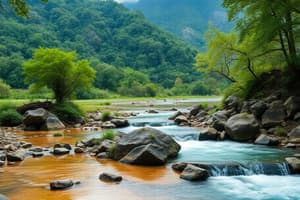Podcast
Questions and Answers
What is the main goal of environmental conservation?
What is the main goal of environmental conservation?
- To use natural resources for current generations
- To protect and preserve natural habitats for future generations (correct)
- To promote unsustainable development
- To increase pollution and waste
What do lines of latitude measure on a map?
What do lines of latitude measure on a map?
- Distance north or south of the equator (correct)
- Distance east or west of the prime meridian
- Distance from the North Pole to the South Pole
- Elevation above sea level
What is the natural process that traps heat in the Earth's atmosphere?
What is the natural process that traps heat in the Earth's atmosphere?
- Greenhouse effect (correct)
- Climate change
- Acid rain
- Ozone depletion
What is the result of excess greenhouse gases in the atmosphere?
What is the result of excess greenhouse gases in the atmosphere?
What is the purpose of conserving water and energy?
What is the purpose of conserving water and energy?
What is the combination of latitude and longitude used for?
What is the combination of latitude and longitude used for?
Flashcards are hidden until you start studying
Study Notes
Environmental Conservation
- Importance of Conservation: Protecting the environment and natural resources for future generations
- Human Impact: Human activities (e.g., deforestation, pollution, overfishing) harm the environment and cause loss of biodiversity
- Ways to Conserve:
- Reduce, Reuse, Recycle
- Conserve water and energy
- Protect and preserve natural habitats
- Reduce pollution and waste
- Promote sustainable development
Latitude and Longitude
- What is Latitude?:
- Measure of distance north or south of the equator (0° to 90°)
- Lines on a map that run parallel to the equator
- What is Longitude?:
- Measure of distance east or west of the prime meridian (0° to 180°)
- Lines on a map that run from the North Pole to the South Pole
- Combining Latitude and Longitude:
- Gives a unique location on the Earth's surface (e.g., 43° 40' N, 79° 24' W)
- Used in navigation, mapping, and geography
Greenhouse Effect
- What is the Greenhouse Effect?:
- Natural process that traps heat in the Earth's atmosphere
- Keeps the planet warm enough to support life
- Greenhouse Gases:
- Carbon dioxide (CO2)
- Methane (CH4)
- Water vapor (H2O)
- How it Works:
- Greenhouse gases absorb infrared radiation from the Earth's surface
- Trapped heat warms the planet
- Excess greenhouse gases enhance the effect, leading to global warming and climate change
Studying That Suits You
Use AI to generate personalized quizzes and flashcards to suit your learning preferences.




